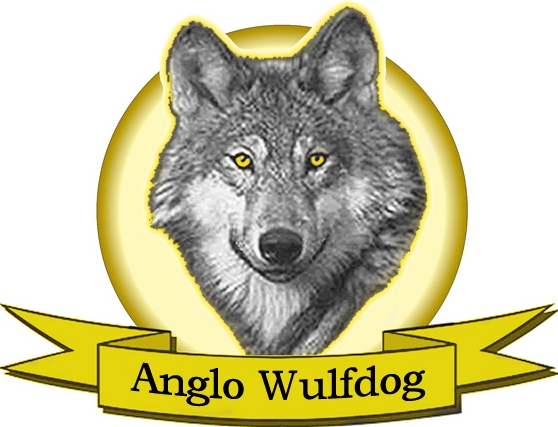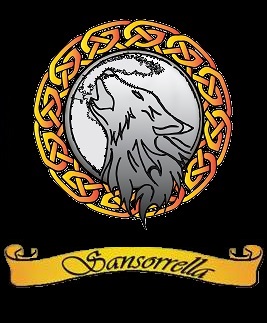


|
|
|

|
"Dream" - Sansorrella Dream the Dream |
|
"Dream" and "Breeze" |
Anglo Wulfdog Origins Breeding Programme began 2009 The name Anglo Wulfdog was chosen as 'Anglo' denotes the English origins and 'Wulfdog' is formed from the Anglo Saxon spelling of wolf - 'Wulf'. Thereby 'Wulfdog' gives the impression of 'Wolfdog' in the same way that our dogs give the impression of being wolves, but aren't. Breed Ancestry: Anglo Wulfdogs have been created through more than 10 years of careful, selective breeding and continue to be improved as the breed develops. The best Northern Inuit foundation bitches were crossed with health tested Alaskan Malamutes - proven to be clear of genetic diseases - to give improved coat, bone and substance. Saarloos Wolfdogs were also included in the early crosses to enhance the wolfish appearance and nature. The best offspring were then selected to be crossed with Czechoslovakian Wolfdogs for added intelligence and trainability and Czechoslovakian Wolfdog x American Wolf hybrids to reinforce the wolfish appearance. This mix has ultimately given us a dog with an authentic wolfish appearance that makes a loyal family companion. All Anglo Wulfdog breeders use only pedigrees known to be true from first hand knowledge of the dogs themselves. DNA profiling of all breeding stock and micro chipping litters ensures accurate, honest and irrefutable records for the future. All breeding dogs are hip scored and "Embark" tested, not only for genetic breed make-up but for over 160 genetic diseases. Although we now have a wide gene pool available we would outcross again in the future if the co-efficiency of inbreeding (COI) ever went above 6.25%, as breeding for health and temperament is of paramount importance. |
"Breeze" - Sansorrella Windsong |
Profile: Anglo Wulfdogs are not suitable for novices as they can be very demanding, especially in the early months; they need experienced owners who are confident leaders they can learn to trust. Ownership is a partnership, a bond of mutual respect. Family members are their pack. The Anglo Wulfdog is a very affectionate dog with their own family but can be aloof or even wary of strangers. They fit in well with our modern day lifestyle as a loyal pet and are capable of competing successfully in obedience, agility etc. with perseverance and patient training. Where the Anglo Wulfdog has not proved a success is as a guard dog, due to their timidity and wariness. Anglo Wulfdogs are independent, strong willed but intelligent dogs that are trainable. Owners need to be committed, patient and have a good sense of humour. |
|
|
They have an incredible
sense of smell and have the potential to provide future services such as
Search and Rescue dogs. A handful of dogs have qualified as P.A.T. dogs. Several
Anglo Wulfdogs have passed the KC Good Citizen Award scheme,
achieving Bronze, Silver and Gold standard for their proud owners. These dogs have an extremely high prey drive and should always be supervised around other domestic pets, livestock and wildlife. People do keep them successfully in households with cats but it is recommended that they never be left alone in the same room - no matter how well they appear to get on in the owner's presence. |
|
| They make great family members and like to be included in
everything the family does.
They love children and are happy to play
games or just cuddle up on the sofa. However,
they do have a tendency to play with small children in the same way they
play with their own siblings and may nip or mouth them if allowed to
become over excited, they are also very boisterous and could easily
knock over a small child so they should always be supervised around small
children (as should all dogs).
Those that are privileged to own an Anglo
Wulfdog, or more,
know how loving and caring these dogs truly are. |
|
"Dream" |
|
"Soul" |
|
Anglo
Wulfdogs are larger than a Siberian husky and most German Shepherds, with dense double coats
ranging in colour from white through to black and reds, with grey being
the most common. They
have sable coats.
They
can have a ‘mask’ but colour change should be subtle.
They moult twice a year; the heaviest being the spring moult but
good brushing keeps this under control. They tend to lose condition when they have a big moult but soon gain
weight again with careful feeding. Most Anglo Wulfdogs do not tolerate cereal based complete dogs foods very well and as a whole they do best on BARF diets. (Biologically Appropriate Raw Food) |
|
|
|
|
|
Anglo Wulfdogs play rough |
|
"Dream" and younger sister "Grace" |
Anglo Wulf Behaviour and temperament of individual dogs will be shaped as much by Nurture as Nature. Handling, training and socialisation affects how a dog will behave. As with every breed there are always exceptions to the rule. There are dogs who will guard their territory, some are more independent and aloof than others. Not all will submit when challenged; as they are predominantly a pack animal there will always be those with Alpha tendencies. |
"Breeze" |

"Grace" - Sansorrella Saving Grace - 4 months |
| NOTE: Breeders participating in the Anglo Wulfdog breeding programme have been concerned for some time by the recurring health and temperament issues arising in wolf 'lookalike' type dogs as a consequence of chronic inbreeding, especially in the Northern Inuit dogs which reached a genetic bottleneck many years ago. Advice was taken from leading genetics experts and a programme devised to ensure a healthier, more viable wolfdog breed in the future. There has been a lot of conjecture and debate as to whether Northern Inuit dogs ever had any wolf content. Recent advances in the science of DNA has enabled me to test the DNA of all my own dogs, thereby confirming my opinion that there was very little wolf content in the breed. At least one on my Northern Inuit lines had no wolf content whatsoever until I introduced it very recently. One of my lines had a trace, which shows I originally had 6% wolf in that line about 15 years ago. All my original Northern Inuits came from the same breeder who helped create that breed. When I was breeding Northern Inuits I used a number of different stud dogs and have now been able to trace the generations back genetically to one wolf that contributed to some Northern Inuit dogs through early Olderhill lines. I have increased the wolf content of Anglo Wulfdogs significantly through the addition of established European and American wolfdog breeds. However, under DEFRA classification they remain a sufficient number of generations away from the wolf to NOT need a DWA Licence . |
|
"Ruby" - Sansorrella Lady in Red "I'm working for the creation. I refuse to take part in it's destruction" Leon Shanandoah - Iroquois |

Click link to find out more about the breeding programme


![]() Sansorrella 2019 All rights reserved
Sansorrella 2019 All rights reserved